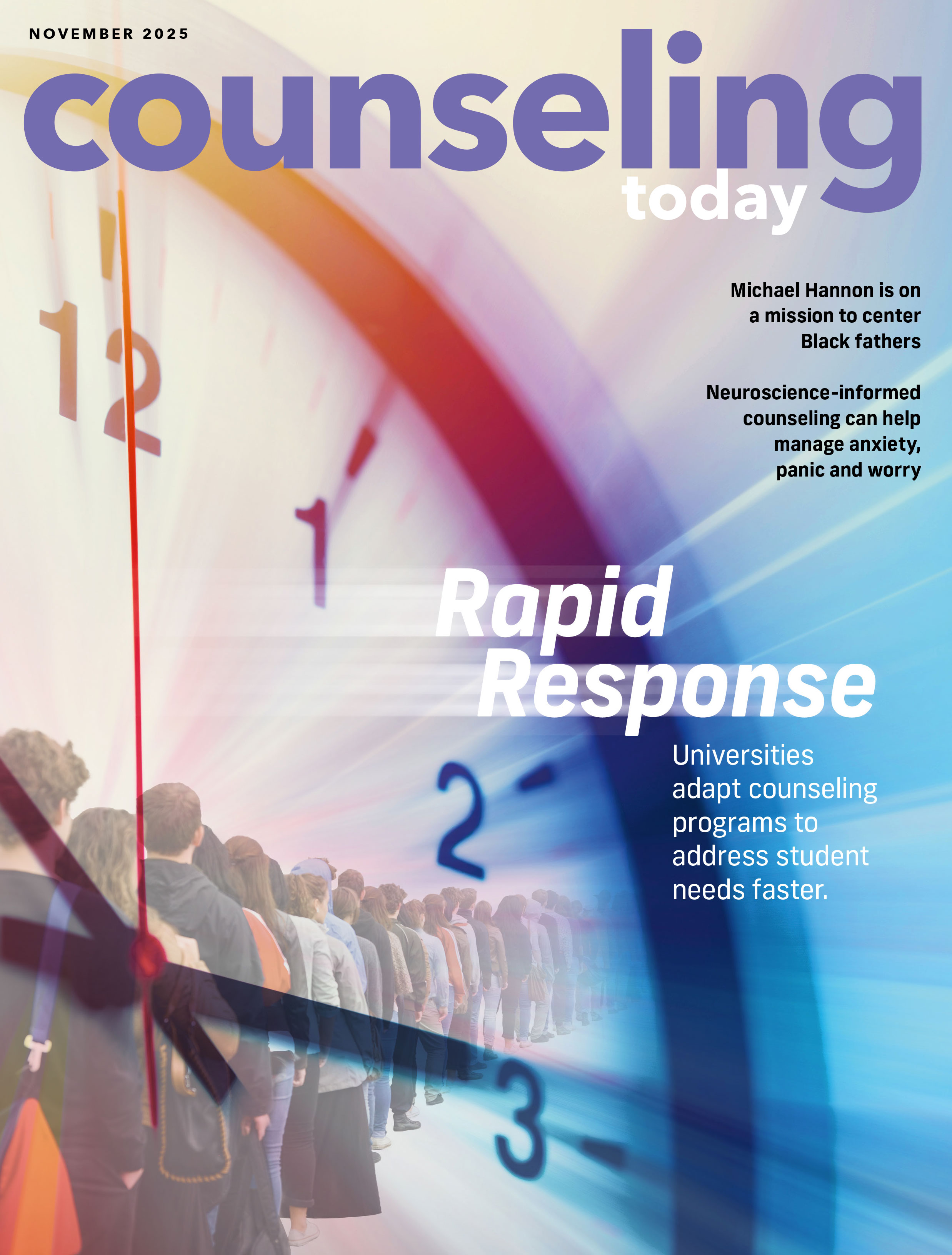Thinking in the Middle
By David Vogt, LPC
May 2025

Counselors who work with adolescents and teenagers often hear about interpersonal concerns, from dysfunctional families and abuse to peer arguments and struggles forming healthy friendships. As adolescents progress through the psychosocial stage of identity versus role confusion, relationships and conflicts become paramount.
Clients frequently describe conflict as a chief complaint in counseling sessions. However, some adolescents experience such an impairment in interpersonal relations that mental health professionals might spot signs of an emerging borderline personality disorder (BPD). In such cases, early detection and intervention can help to mitigate symptoms and behaviors, especially if a full diagnosis would be inappropriate due to age.
Multiple concerns arise when addressing the topic of BPD in adolescents. As with any personality disorder, diagnosis in a teenager remains controversial and ambiguous. Personality disorders are normally not diagnosed until a client is at least 18; some symptoms and behaviors commonly found in BPD, such as conflictual relationships, strong emotions and an unstable sense of self, are, to some degree, expected in teenagers.
The DSM-5 does allow a personality disorder diagnosis for adolescents if symptoms and behaviors have been stable and pervasive for at least one year. Nonetheless, some adolescents do present with features of BPD that become relevant in counseling, regardless of whether they qualify for a diagnosis. An adolescent might report a strong fear of abandonment affecting their relationships or a history of unstable friendships and self-harm or suicidal ideation, or they might define themselves as having “anger issues.” Anger in relationships and impulsivity are notable complaints that can signal to counselors that an adolescent may be developing traits of BPD.
The use of language presents another concern. For adolescent clients with BPD features, terminology becomes relevant. After all, what is the proper way to refer to such an individual? Options include terms such as pre-borderline, emerging borderline, provisional borderline or the person-centered adolescent with features of BPD. This article uses pre-borderline; however, clinicians can choose the most appropriate language for their clients.
While dialectical behavior therapy (DBT) can be effective when working with BPD, not all clinicians have intensive training or certifications to implement DBT in its purest form.
However, counselors can use techniques from DBT, cognitive behavioral therapy (CBT) and Rogerian skills when serving pre-borderline clients or any adolescents who present with behaviors found in a BPD diagnosis.
Working with a client who might be developing a personality disorder can be overwhelming, but counselors at any level can provide meaningful and impactful help through integrated models and an authentic, genuine relationship.
Trauma, Families and Contributing Factors
Conceptualizing a client as pre-borderline is risky and not always appropriate. While certain factors may raise internal alarms, careful consideration of the client’s individual case is needed before making a diagnostic impression. Additionally, adolescents may present with comorbid factors, such as depression, anxiety and trauma, which can be explored and treated first.
They may report experiencing violent, sudden rushes of feelings, akin to “spirals” or “tsunamis,” which the client does not know how to understand or manage. Counselors may notice similar patterns in the adolescent’s family if a parent’s lack of emotional regulation and healthy communication skills has passed down to children.
Counselors can educate clients on the nature and origins of BPD by explaining the “perfect storm” of emotional sensitivity on a neurological level combined with an invalidating environment. This concept usually resonates strongly with pre-borderline clients, who are quick to identify how they have felt invalidated by others or through trauma.
Using language carefully and sensitively is important for counselors. As adolescents are still building their sense of self, they might hastily rush toward any label that could summarize their lives. If a diagnostic impression becomes appropriate, counselors can educate clients on the complications of a personality disorder diagnosis at their age while offering them ways to conceptualize it. Counselors and clients can collaborate on meaning and identity if using borderline-centered language and terminology becomes appropriate.
Finding Middle Ground
“Thinking in the middle” can be a developmentally appropriate, memorable way to refer to balancing out all-or-nothing thinking — or splitting — which is a common trait in both individuals with BPD and adolescents in general. Thinking in the middle means finding a realistic, helpful middle ground in one’s conceptions of people and situations. In this regard, it borrows heavily from the DBT concept of dialectics. Counselors can explore this technique more fully in later stages of counseling or incorporate it as a continuous goal throughout treatment.
When working with pre-borderline clients, building a therapeutic alliance through Rogerian skills such as active listening and validation is an important first step. Many adolescent clients have never heard of the concept of validation and have never considered how they might have felt invalidated in their lives. Teaching adolescents that their feelings are real and important is often a novel idea that provides enormous relief.
Counselors can use feeling wheels with clients to help them find specific, accurate language for their emotional experiences, thus helping them find a focused “middle” as opposed to more extreme terminology. In addition, sentence-starters such as “I feel ___ right now and that’s OK” can help clients label their feelings, self-validate and remember a negative feeling will pass, thus increasing their tolerance for distress.
When helping adolescents think in the middle, counselors can use reframing as a powerful tool to help clients modify their language. Once the therapeutic alliance has been built, counselors can point out how clients have used splitting language or how they could view a situation differently. Borrowing from CBT, counselors can use the cognitive model to help clients reframe self-talk and inner analyses of situations that might trigger anger. Counselors can also help clients view other people in terms of “strengths and weaknesses” instead of being “all bad” or “all good” by using Venn diagrams or the clients’ experiences.
In addition, counselors can teach adolescents coping skills throughout their treatment and incorporate the DBT module of mindfulness. Counselors can collaborate with clients to create a list of self-care activities, such as coloring, walking, playing musical instruments or journaling. Clients can choose one to try daily until their next session to see what helps them and fits their lifestyle. The end goal is to build an enduring self-care routine. Some activities, such as meditation or yoga, can be practiced together in sessions to help the client feel comfortable.
As adolescents learn to think in the middle and self-regulate, their self-talk and communication with others can become more grounded and manageable. Counselors can then ask clients to identify what is in the “middle” when they describe situations or relationships using splitting-influenced language. With positive and consistent challenging, they can learn to validate themselves and others once they can view their feelings from the middle.
Practicing Relationships
For adolescent clients of any kind, developing healthy relationships is a crucial skill to learn in counseling. This skill becomes especially relevant for pre-borderline adolescents, who struggle to think in the middle and might crave, yet fear, relationships. With these clients, counselors can do a “relationship check-in” at the end of each session. During the relationship check-in, the client can share thoughts about the therapeutic relationship, such as if the counselor feels too close or distant, if something in the session made them feel uncomfortable or if they have feedback for the counselor.
Relationship check-ins give clients a chance to practice open communication about the state of a relationship with a partner (the counselor) who will not respond with anger or invalidation. Counselors should respect and acknowledge the client’s honesty. The counselor might then offer their view of the relationship, allowing the client to see a healthy relationship involves communication from both parties. This also allows for transition into systemic-focused work such as family counseling. Ethical, supportive involvement of the client’s family is often crucial when working with adolescents.
While every individual case is different, and while borderline features may or may not be signs of an emerging BPD, teaching adolescents how to self-validate and think in the middle can ease distress and improve the quality of life for clients and their families.
David Vogt, LPC, is a nationally certified counselor in Alabama. He has a background in education and works in a rural community mental health setting with children and adolescents.


